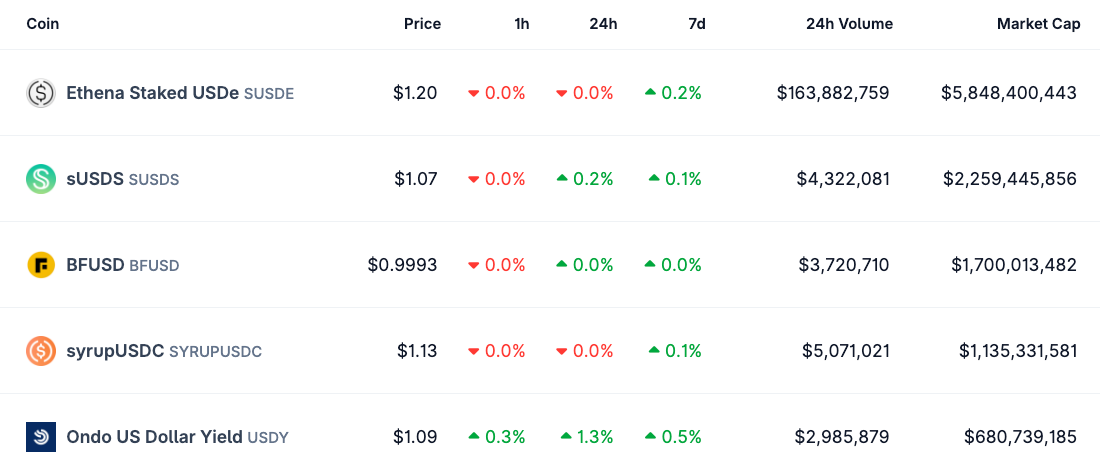Stablecoin duopoly refers to USDT and USDC dominating the market; that dominance is slipping as yield-bearing challengers and bank-backed consortia gain share, dropping the USDT+USDC combined market share from 91.6% in early 2024 to about 83.6% today.
-
USDT and USDC combined market share has fallen from 91.6% to ~83.6%.
-
Emerging yield-bearing stablecoins like Ethena’s USDe have grown rapidly, changing competitive dynamics.
-
Bank consortia and regulatory shifts (e.g., MiCA, GENIUS discussions) increase issuance options and distribution channels.
Primary keyword: stablecoin duopoly — Learn why USDT and USDC market share is declining and what new issuers mean for stablecoin investors. Read more.
Despite dominating stablecoin inflows, Tether’s USDt and Circle’s USDC have slowly lost market share, signaling the end of the “stablecoin duopoly.”
Despite Tether’s USDt (USDT) and Circle’s USDC (USDC) steadily increasing nominal market capitalizations, their combined dominance of the stablecoin market has declined meaningfully since early 2024. Data tracked by industry aggregators such as DefiLlama and CoinGecko show a notable shift in market share allocation.
What is the stablecoin duopoly and is it ending?
The stablecoin duopoly describes USDT and USDC controlling the majority of circulating stablecoins. Their combined share peaked at 91.6% in March 2024 and has since declined to roughly 83.6%, driven by yield-bearing entrants and new bank-issued initiatives.
How have USDT and USDC market shares changed since 2024?
USDT and USDC reached a combined market capitalization share of 91.6% when the market was near $140 billion. At that peak, USDT was ~ $99 billion and USDC ~ $29 billion. Since Oct. 2, 2024, the pair has lost more than 5% of combined share, now roughly 83.6%.

Market capitalization of USDT and USDC versus total stablecoin market cap. Sources: DefiLlama, CoinGecko
Why are challengers gaining traction?
New issuers are offering yield-bearing mechanics, attractive passive returns, and varied collateral frameworks. Nic Carter, partner at Castle Island Ventures, notes that intermediaries and startups are becoming more assertive, creating a “race to the bottom with yield” or a competitive yield frontier that undercuts legacy issuers.
Ethena’s USDe is singled out as the largest recent success, expanding supply to an estimated $14.7 billion by offering yield derived from basis trading strategies. Other notable entrants include Sky’s USDS, PayPal’s PYUSD, World Liberty’s USD1, Ondo’s USDY, Paxos’ USDG, and Agora’s AUSD (all referenced as plain text sources).
How will bank-issued stablecoins affect the market?
Regulatory changes and bank collaboration are reshaping distribution. Carter argues that consortia of banks are the most plausible challengers because no single bank has the distribution to match Tether. Recent European efforts, including a joint venture involving ING and UniCredit under MiCA compliance, aim to issue a euro-denominated stablecoin in H2 2026.

Five top yield-bearing stablecoins by market cap. Source: CoinGecko
What regulatory and market risks should readers consider?
Yield-bearing stablecoins face scrutiny in legislative discussions like the US GENIUS Act. Regulatory pressure can alter product structures and distribution. Investors should watch official regulatory texts, market-cap data from monitoring services such as DefiLlama and CoinGecko, and announcements from major payment firms and banks.
Frequently Asked Questions
How quickly is the stablecoin duopoly dissolving?
The duopoly has declined from 91.6% in March 2024 to about 83.6% now, a drop of roughly 8 percentage points. The pace depends on issuance velocity of yield-bearing coins and bank consortia rollout timetables.
Are yield-bearing stablecoins safe?
Yield-bearing stablecoins carry additional counterparty and market risks versus traditional fiat-backed stablecoins. Regulatory safeguards and transparent reserve reporting improve trust, but returns often reflect higher structural complexity.
Key Takeaways
- Declining dominance: USDT and USDC combined share fell from 91.6% to ~83.6% since early 2024.
- New competition: Yield-bearing stablecoins, led by Ethena’s USDe, and bank consortia are reshaping market dynamics.
- Investor action: Track transparent reserve reporting, yield mechanics, and regulatory developments before reallocating capital.
Conclusion
The stablecoin duopoly is under pressure as yield-bearing entrants and bank-backed consortia expand supply and distribution. Market-share declines, expert commentary from Nic Carter, and on-chain data point to a more fragmented stablecoin landscape. Market participants should watch issuance trends, regulatory signals, and reserve disclosures closely.
